Search Result
Results for "
Iodoacetamide
" in MedChemExpress (MCE) Product Catalog:
1
Isotope-Labeled Compounds
| Cat. No. |
Product Name |
Target |
Research Areas |
Chemical Structure |
-
- HY-34477
-
|
Iodoacetamide
|
|
|
|
2-Iodoacetamide (Iodoacetamide), an alkylating agent, is a commonly used agent for alkylation of cysteine during sample preparation for proteomics .
|
-

-
- HY-34477S1
-
|
Iodoacetamide-d4
|
DNA Alkylator/Crosslinker
|
Others
|
|
2-Iodoacetamide-d4 is the deuterium labeled 2-Iodoacetamide[1]. 2-Iodoacetamide (Iodoacetamide), an alkylating agent, is a commonly used agent for alkylation of cysteine during sample preparation for proteomics[2][3].
|
-
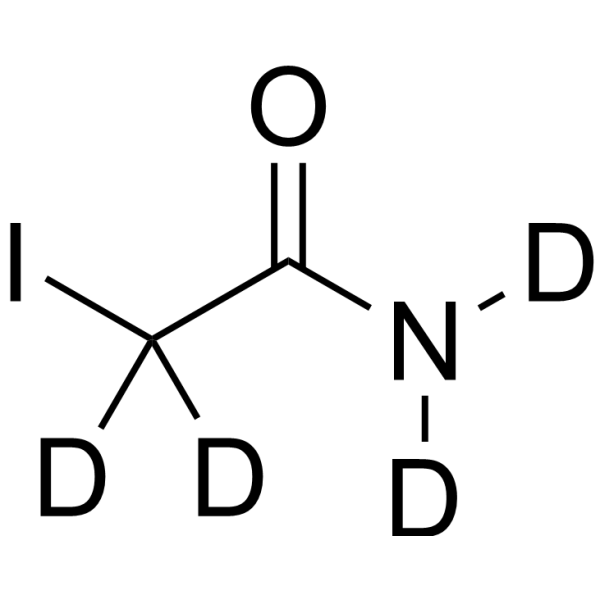
-
- HY-140857
-
|
|
PROTAC Linkers
|
Cancer
|
|
Iodoacetamide-PEG3-azide is a PEG-based PROTAC linker that can be used in the synthesis of PROTACs . Iodoacetamide-PEG3-azide is a click chemistry reagent, it contains an Azide group and can undergo copper-catalyzed azide-alkyne cycloaddition reaction (CuAAc) with molecules containing Alkyne groups. Strain-promoted alkyne-azide cycloaddition (SPAAC) can also occur with molecules containing DBCO or BCN groups.
|
-
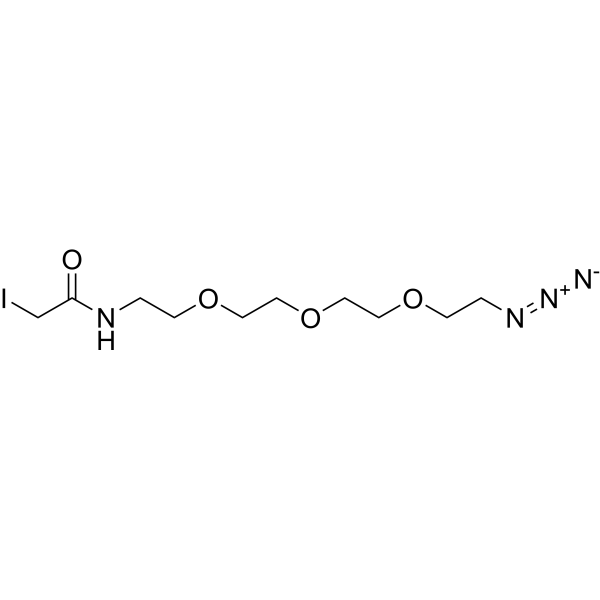
-
- HY-134738
-
|
|
PROTAC Linkers
|
Cancer
|
|
Iodoacetamide-PEG5-NH-Boc is a PEG-based PROTAC linker that can be used in the synthesis of PROTACs .
|
-
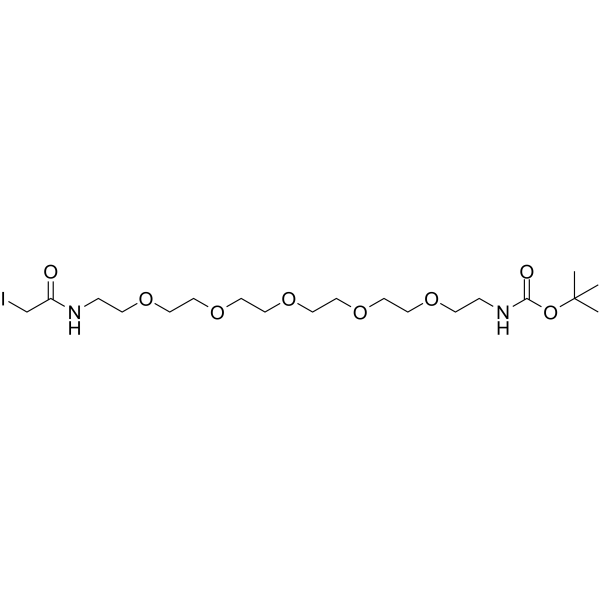
-
- HY-134687
-
|
|
PROTAC Linkers
|
Cancer
|
|
Iodoacetamide-PEG5-azide is a PEG-based PROTAC linker that can be used in the synthesis of PROTACs . Iodoacetamide-PEG5-azide is a click chemistry reagent, it contains an Azide group and can undergo copper-catalyzed azide-alkyne cycloaddition reaction (CuAAc) with molecules containing Alkyne groups. Strain-promoted alkyne-azide cycloaddition (SPAAC) can also occur with molecules containing DBCO or BCN groups.
|
-
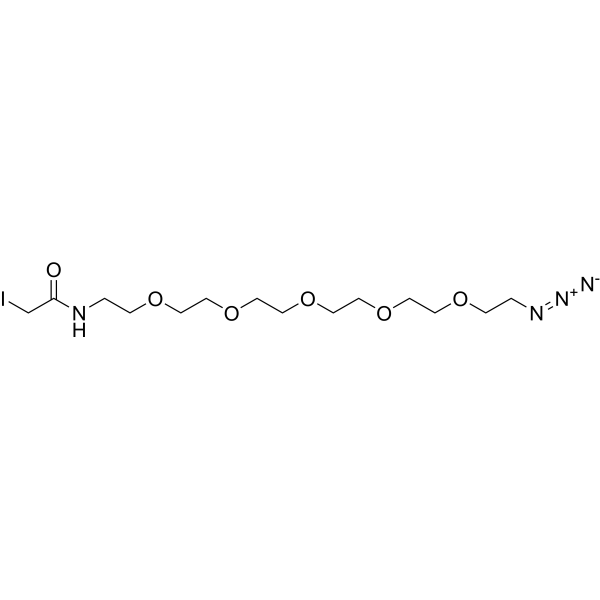
-
- HY-134688
-
|
|
PROTAC Linkers
|
Cancer
|
|
Iodoacetamide-PEG5-NH2 is a PEG-based PROTAC linker that can be used in the synthesis of PROTACs .
|
-
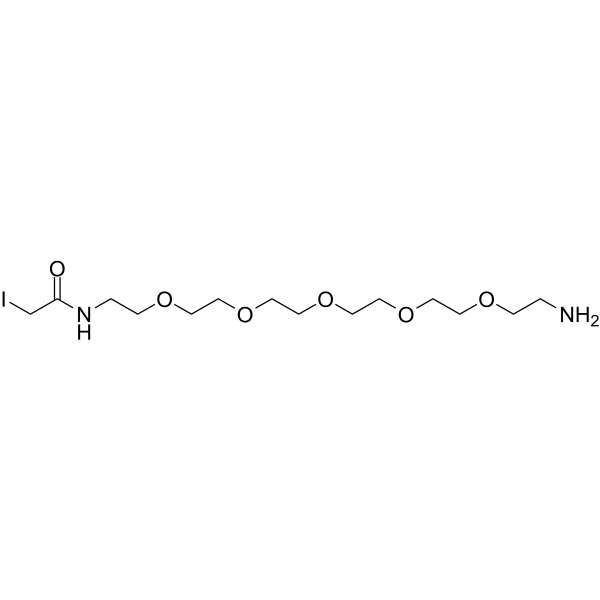
-
- HY-136205
-
|
Iodoacetamide-alkyne; N-Hex-5-ynyl-2-iodo-acetamide
|
TRP Channel
|
Infection
Inflammation/Immunology
|
|
IA-Alkyne (Iodoacetamide-alkyne; N-Hex-5-ynyl-2-iodo-acetamide) is a TRP channel (TRPC) agonist and has the potential for the study of respiratory infection . IA-Alkyne can be used to develop an isotopically tagged probe for quantitative cysteine-reactivity profiling . IA-Alkyne is a click chemistry reagent, it contains an Alkyne group and can undergo copper-catalyzed azide-alkyne cycloaddition (CuAAc) with molecules containing Azide groups.
|
-
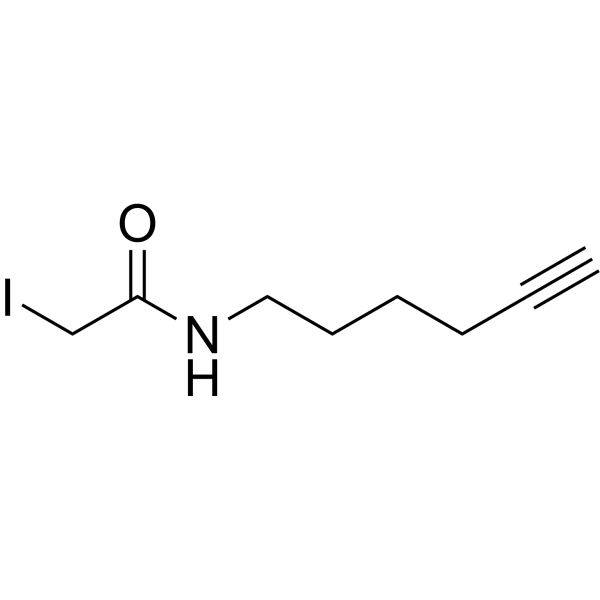
-
- HY-150230
-
|
|
ADC Linker
|
Others
|
|
Desthiobiotin-Iodoacetamide can be used as an ADC Linker. Desthiobiotin-Iodoacetamide also acts as a probe used to label the the Oridonin (HY-N0004)-treated cell lysis .
|
-

-
- HY-123749
-
|
5-TMRIA
|
Fluorescent Dye
|
Others
|
|
Tetramethylrhodamine-5-iodoacetamide (5-TMRIA) is a thiol-selective reactive dye that is used to non-specifically label proteins via the cysteine residues. Tetramethylrhodamine-5-iodoacetamide (5-TMRIA) can be used to covalently label DNA fragments .
|
-
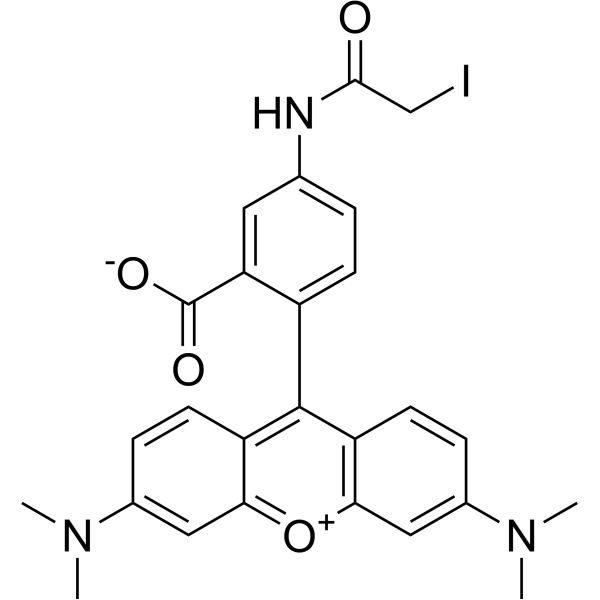
-
- HY-D1921
-
|
|
Fluorescent Dye
|
Others
|
|
ATTO 390 iodoacetamide is the iodoacetamide derivative of ATTO 390, the maximum excitation/emission wavelength: 390/476 nm.
|
-
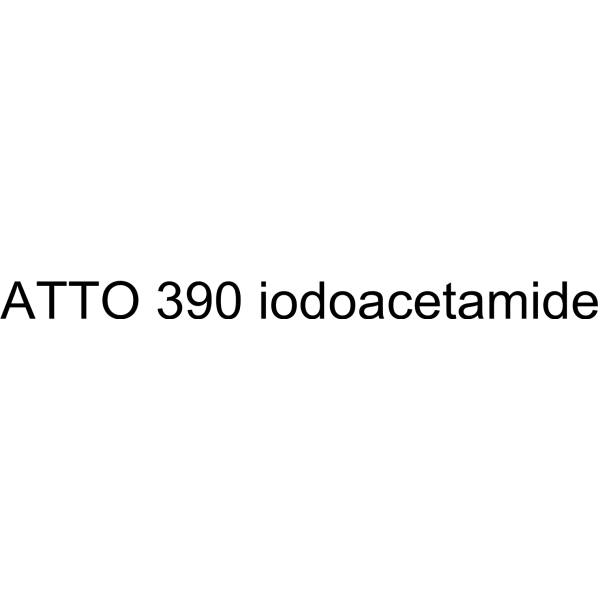
-
- HY-134718
-
|
|
PROTAC Linkers
|
Cancer
|
|
Glycocholic acid-PEG10-iodoacetamide is a PEG-based PROTAC linker that can be used in the synthesis of PROTACs .
|
-
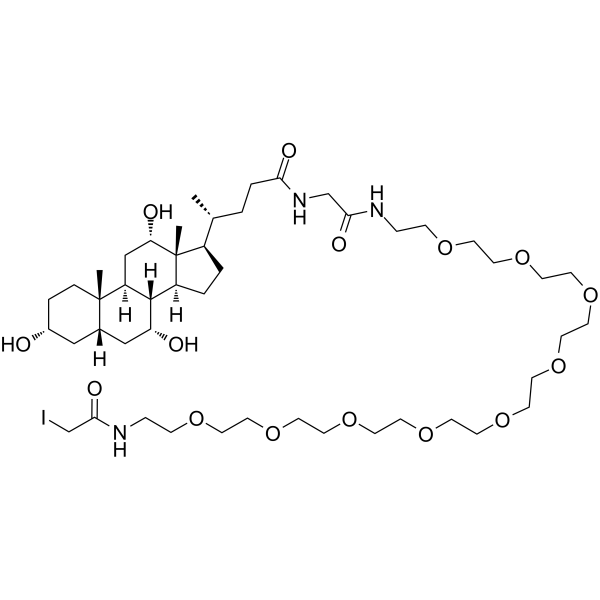
-
- HY-143205
-
|
|
Others
|
Cancer
|
|
Desthiobiotin polyethyleneoxide iodoacetamide is useful for cysteine labeling in chemoproteomic experiments .
|
-
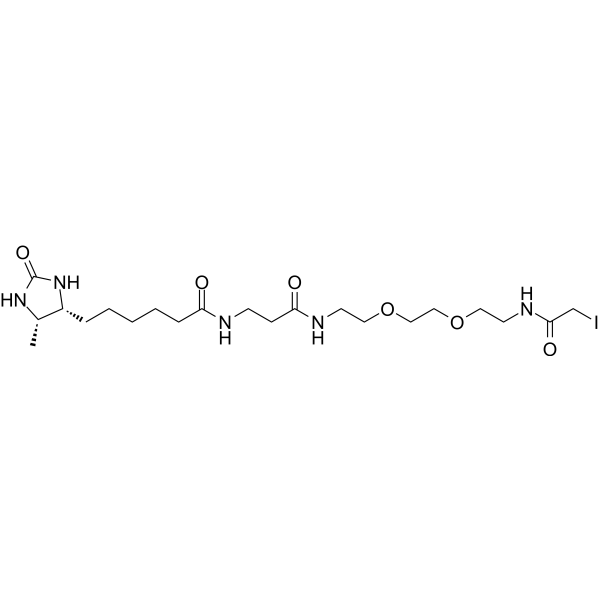
-
- HY-140941
-
|
|
PROTAC Linkers
|
Cancer
|
|
Biotin-PEG2-C2-iodoacetamide is a PEG-based PROTAC linker that can be used in the synthesis of PROTACs .
|
-
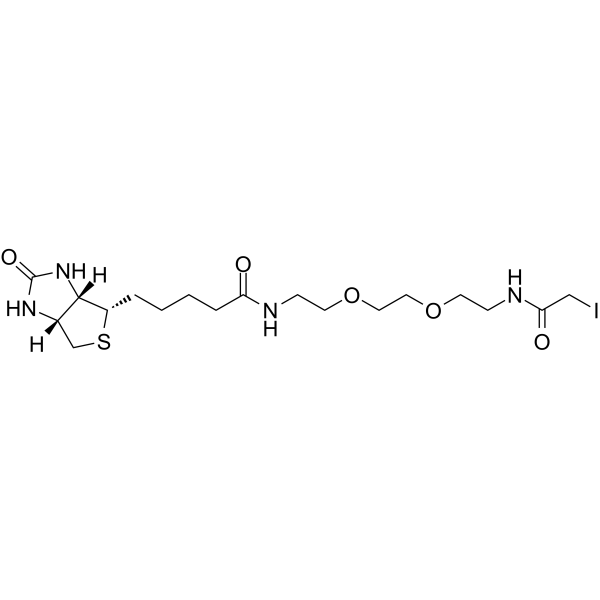
-
- HY-149182
-
-
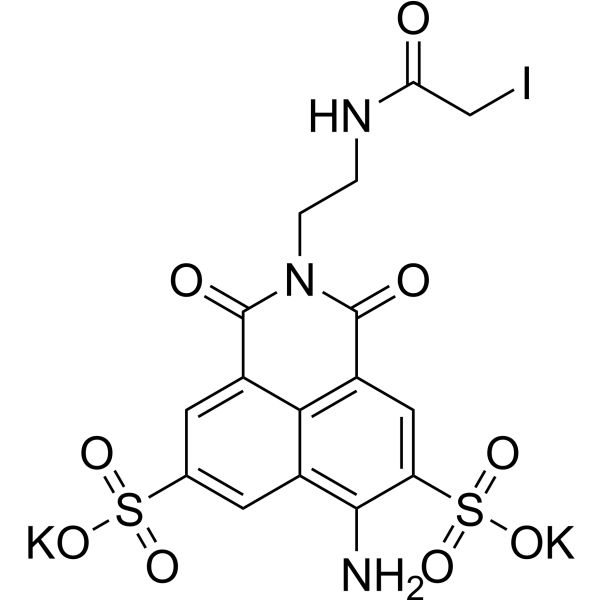
-
- HY-D1981
-
|
|
Fluorescent Dye
|
Others
|
|
ATTO 633 Iodacetamid is an iodoacetamide derivative of ATTO 594 with excitation/emission maxima at 630/651 nm.
|
-
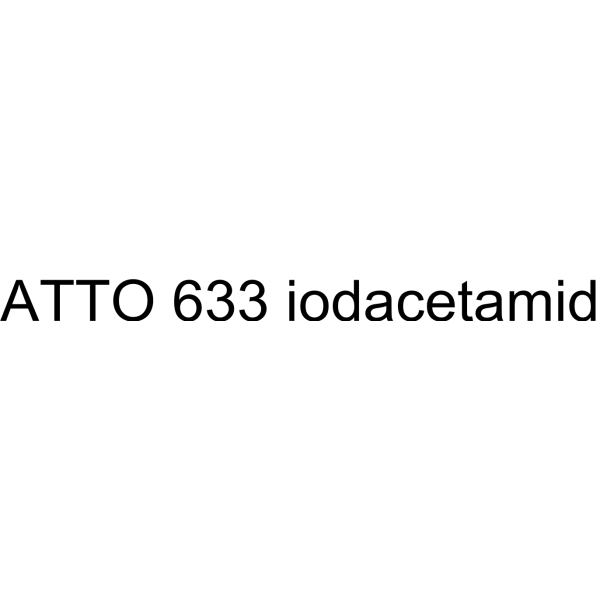
-
- HY-D1945
-
|
|
Fluorescent Dye
|
Others
|
|
ATTO 590 Iodacetamid is an iodoacetamide derivative of ATTO 590 with maximum excitation/emission wavelengths: 594/622 nm.
|
-
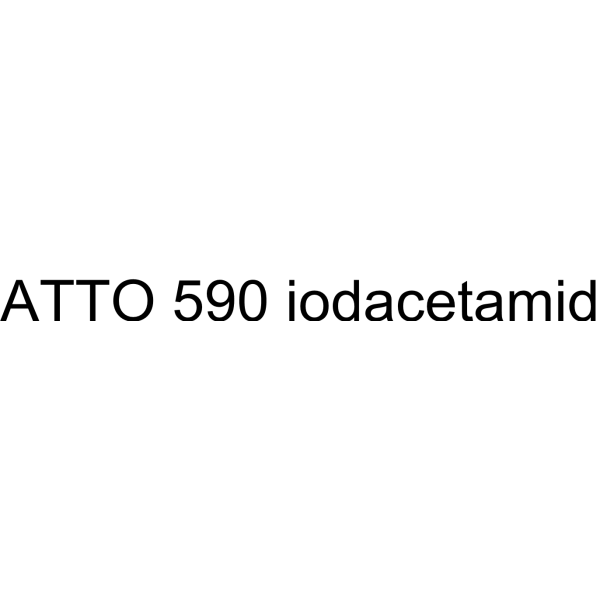
-
- HY-D2009
-
|
|
Fluorescent Dye
|
Others
|
|
ATTO 565 iodacetamid is an iodoacetamide derivative of ATTO 565 with maximum excitation/emission wavelengths: 564/590 nm.
|
-
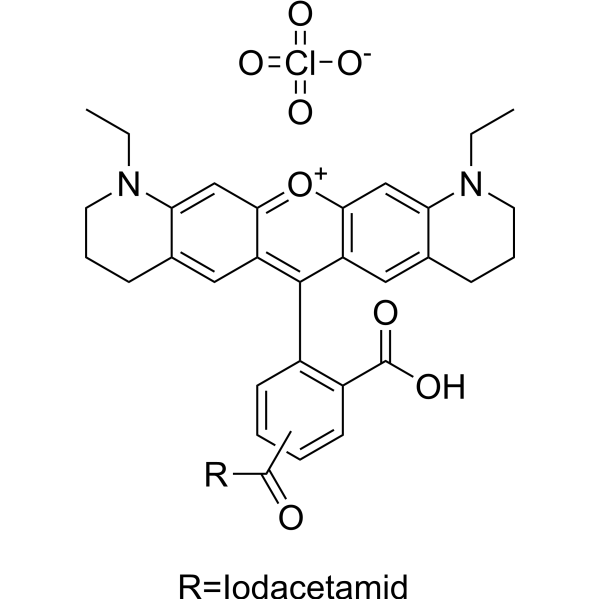
-
- HY-D2068
-
|
|
Fluorescent Dye
|
Others
|
|
ATTO 680 iodacetamid is an iodoacetamide derivative of ATTO 680 with maximum excitation/emission wavelengths: 681/698 nm.
|
-
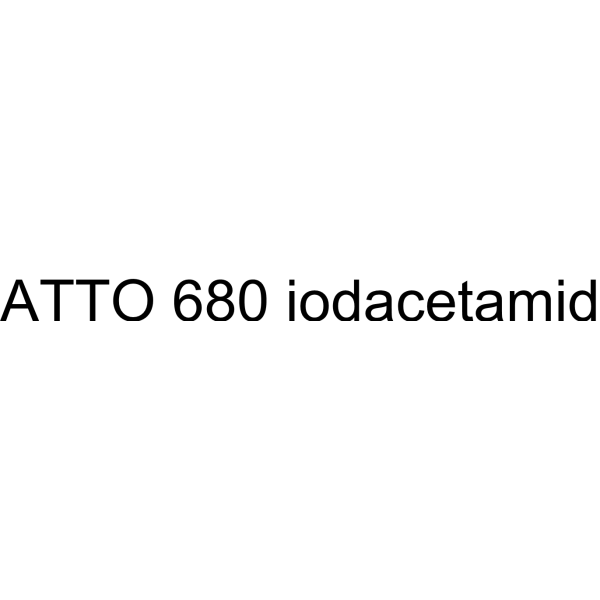
-
- HY-D2036
-
|
|
Fluorescent Dye
|
Others
|
|
ATTO 550 iodacetamid is an iodoacetamide derivative of ATTO 550 with maximum excitation/emission wavelengths: 554/576 nm.
|
-

-
- HY-D2080
-
|
|
Fluorescent Dye
|
Others
|
|
ATTO 665 iodacetamid is an iodoacetamide derivative of ATTO 665 with maximum excitation/emission wavelengths: 663/680 nm.
|
-
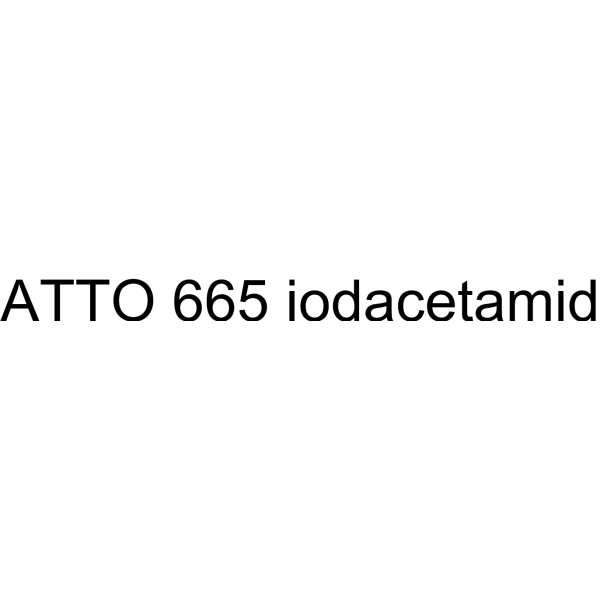
-
- HY-D2052
-
|
|
Fluorescent Dye
|
Others
|
|
ATTO 532 iodacetamid is a new fluorescent marker based on the Rhodamine structure. It has strong absorption, high fluorescence quantum yield, high thermal stability and photochemical stability, and is suitable for single molecule detection and high-resolution microscopy. ATTO 532 iodacetamid is an iodoacetamide derivative of ATTO 532, which can be used to label proteins or antibodies.
|
-

-
- HY-P3567
-
|
|
Melanocortin Receptor
|
Neurological Disease
|
|
(p-Iodo-Phe7)-ACTH (4-10) is a adrenocorticotrophic hormone (ACTH) derivative, which is produced and secreted by the anterior pituitary gland. (p-Iodo-Phe7)-ACTH (4-10) serves as a melanocortin (MC) receptor antagonist and inhibits α-melanocyte-stimulating hormone (α-MSH)-induced excessive grooming behavior in rats .
|
-

-
- HY-P4154
-
|
ALM-488
|
Fluorescent Dye
|
Neurological Disease
|
|
Bevonescein (ALM-488) is a novel, intravenously-administrated fluorescein-conjugated peptide that binds nerve-associated connective tissue, labels peripheral nerves under real-time fluorescence imaging (FL) in living mice and human ex vivo nerve tissue. Bevonescein is a peptide-linked tracer which fluorescently labeled both intact and degenerated nerves .
|
-
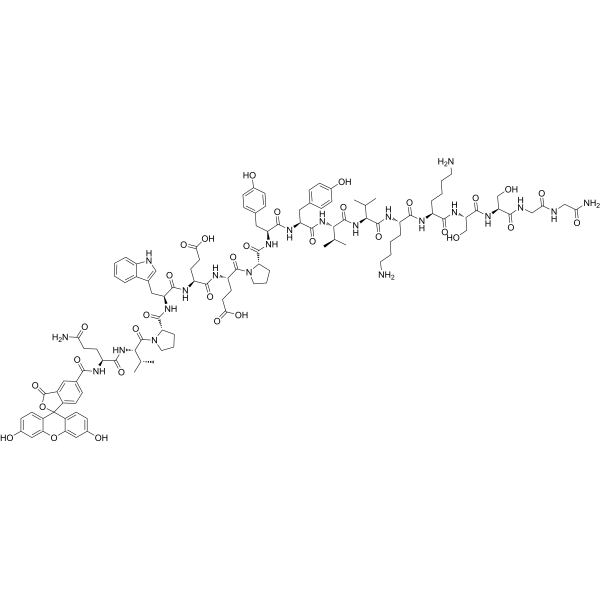
-
- HY-P2434
-
|
|
Somatostatin Receptor
|
Neurological Disease
Metabolic Disease
Cancer
|
|
AP102 is a dual SSTR2/SSTR5-specific somatostatin analog (SSA). AP102 is a disulfide-bridged octapeptide SSA containing synthetic iodinated amino acids. AP102 binds with subnanomolar affinity to SSTR2 and SSTR5 (IC50: 0.63 and 0.65 nM, respectively). AP102 does not bind to SSTR1 or SSTR3. AP102 can be used for acromegaly and neuroendocrine tumors research .
|
-
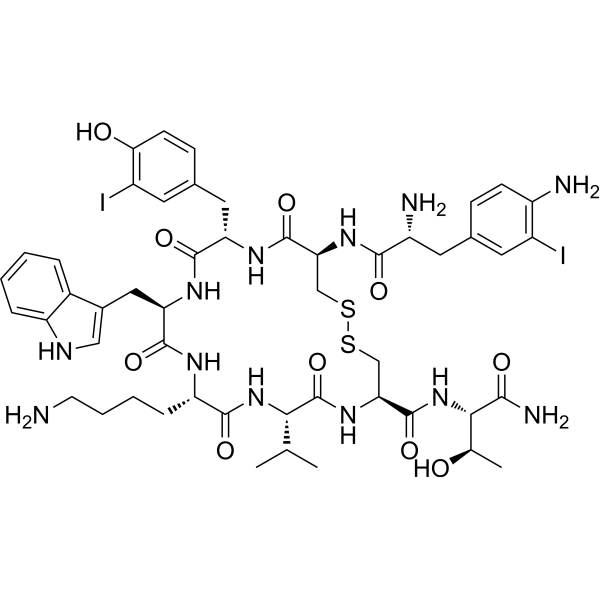
-
- HY-P1103A
-
|
|
CXCR
|
Cancer
|
|
CTCE-9908 TFA is a potent and selective CXCR4 antagonist. CTCE-9908 TFA induces mitotic catastrophe, cytotoxicity and inhibits migration in CXCR4-expressing ovarian cancer cells .
|
-
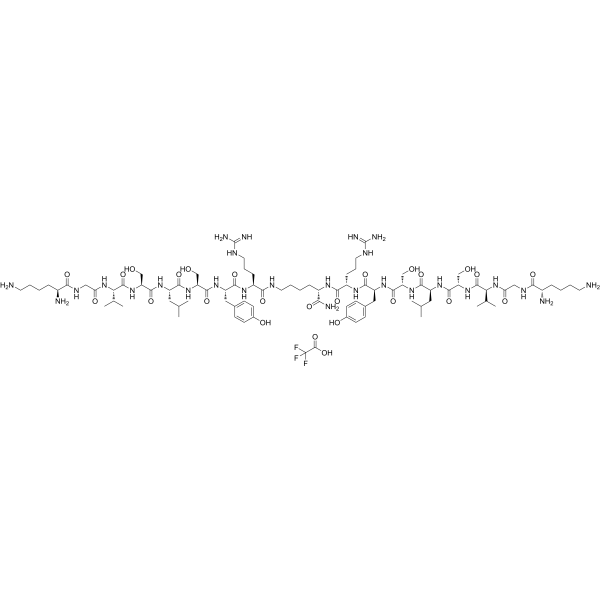
-
- HY-P1103
-
|
|
CXCR
|
Cancer
|
|
CTCE-9908 is a potent and selective CXCR4 antagonist. CTCE-9908 induces mitotic catastrophe, cytotoxicity and inhibits migration in CXCR4-expressing ovarian cancer cells .
|
-
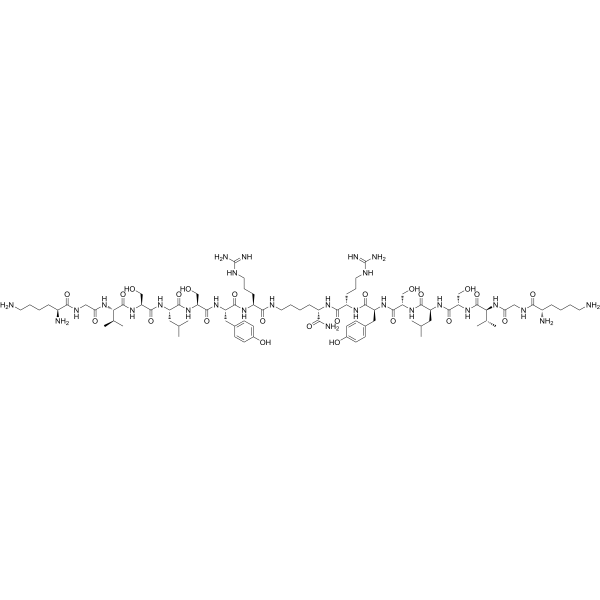
-
- HY-P2231A
-
|
MEDI0382 acetate
|
GCGR
|
Metabolic Disease
|
|
Cotadutide (MEDI0382) acetate is a potent dual agonist of glucagon-like peptide-1 (GLP-1) and GCGR with EC50 values of 6.9 pM and 10.2 pM, respectively. Cotadutide acetate exhibits ability to facilitate both weight loss and glycaemic control, and alleviate fibrosis. Cotadutide acetate can be used in the research of obesity and type 2 diabetes (T2D) .
|
-
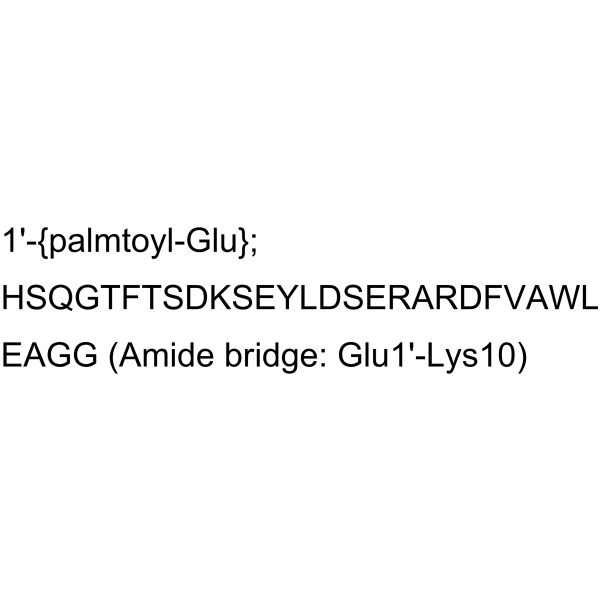
-
- HY-P2231
-
|
MEDI0382
|
GCGR
|
Metabolic Disease
|
|
Cotadutide (MEDI0382) is a potent dual agonist of glucagon-like peptide-1 (GLP-1) and GCGR with EC50 values of 6.9 pM and 10.2 pM, respectively. Cotadutide exhibits ability to facilitate both weight loss and glycaemic control, and alleviate fibrosis. Cotadutide can be used in the research of obesity and type 2 diabetes (T2D) .
|
-
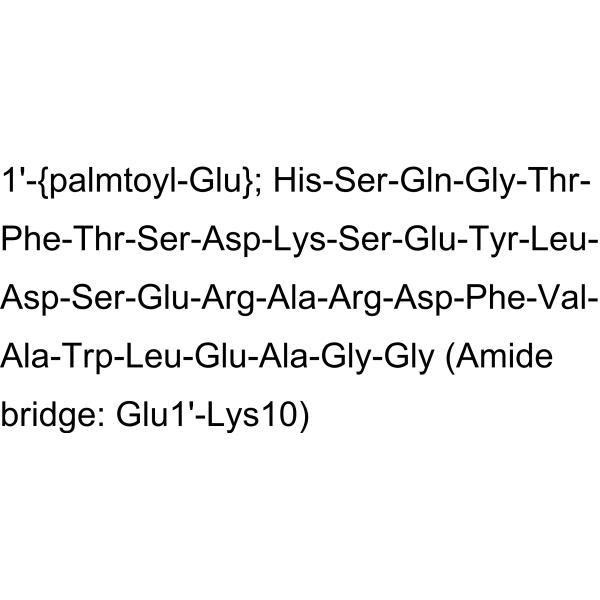
-
- HY-P1321
-
|
1229U91; GW1229
|
Neuropeptide Y Receptor
|
Neurological Disease
|
|
GR231118, an analogue of the C-terminus of neuropeptide Y, is a potent , competitive and relative seletive antagonist at human neuropeptide Y Y receptor with a pKi of 10.4. GR231118 a potent agonist at the human neuropeptide Y Y4 receptor (pEC50=8.6; pKi=9.6) and a weak agonist at the human and rat neuropeptide YY2 and Y5 receptors. GR231118 also has high affinity for the mouse neuropeptide Y Y6 receptor (pKi= 8.8) .
|
-
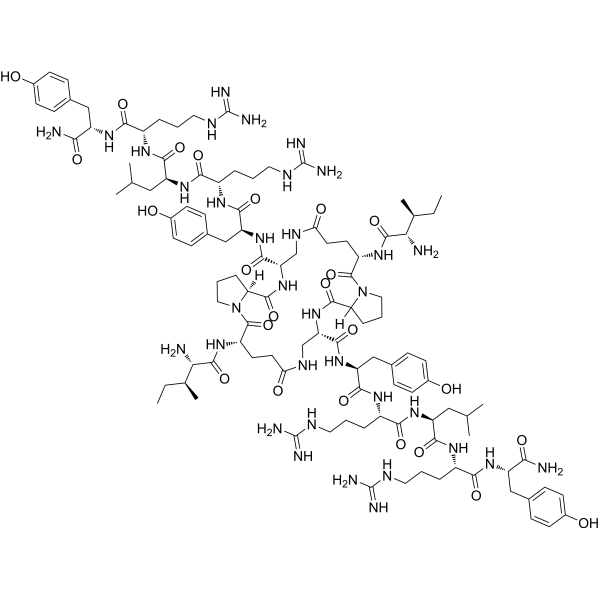
-
- HY-P1321A
-
|
1229U91 TFA; GW1229 TFA
|
Neuropeptide Y Receptor
|
Neurological Disease
|
|
GR231118 TFA, an analogue of the C-terminus of neuropeptide Y, is a potent , competitive and relative seletive antagonist at human neuropeptide YY receptor with a pKi of 10.4. GR231118 a potent agonist at the human neuropeptide YY4 receptor (pEC50=8.6; pKi=9.6) and a weak agonist at the human and rat neuropeptide Y Y2 and Y5 receptors. GR231118 also has high affinity for the mouse neuropeptide YY6 receptor (pKi= 8.8) .
|
-

| Cat. No. |
Product Name |
Type |
-
- HY-123749
-
|
5-TMRIA
|
Dyes
|
|
Tetramethylrhodamine-5-iodoacetamide (5-TMRIA) is a thiol-selective reactive dye that is used to non-specifically label proteins via the cysteine residues. Tetramethylrhodamine-5-iodoacetamide (5-TMRIA) can be used to covalently label DNA fragments .
|
-
- HY-D1921
-
|
|
Fluorescent Dyes/Probes
|
|
ATTO 390 iodoacetamide is the iodoacetamide derivative of ATTO 390, the maximum excitation/emission wavelength: 390/476 nm.
|
-
- HY-149182
-
-
- HY-D1981
-
|
|
Fluorescent Dyes/Probes
|
|
ATTO 633 Iodacetamid is an iodoacetamide derivative of ATTO 594 with excitation/emission maxima at 630/651 nm.
|
-
- HY-D1945
-
|
|
Fluorescent Dyes/Probes
|
|
ATTO 590 Iodacetamid is an iodoacetamide derivative of ATTO 590 with maximum excitation/emission wavelengths: 594/622 nm.
|
-
- HY-D2009
-
|
|
Fluorescent Dyes/Probes
|
|
ATTO 565 iodacetamid is an iodoacetamide derivative of ATTO 565 with maximum excitation/emission wavelengths: 564/590 nm.
|
-
- HY-D2068
-
|
|
Fluorescent Dyes/Probes
|
|
ATTO 680 iodacetamid is an iodoacetamide derivative of ATTO 680 with maximum excitation/emission wavelengths: 681/698 nm.
|
-
- HY-D2036
-
|
|
Fluorescent Dyes/Probes
|
|
ATTO 550 iodacetamid is an iodoacetamide derivative of ATTO 550 with maximum excitation/emission wavelengths: 554/576 nm.
|
-
- HY-D2080
-
|
|
Fluorescent Dyes/Probes
|
|
ATTO 665 iodacetamid is an iodoacetamide derivative of ATTO 665 with maximum excitation/emission wavelengths: 663/680 nm.
|
-
- HY-D2052
-
|
|
Fluorescent Dyes/Probes
|
|
ATTO 532 iodacetamid is a new fluorescent marker based on the Rhodamine structure. It has strong absorption, high fluorescence quantum yield, high thermal stability and photochemical stability, and is suitable for single molecule detection and high-resolution microscopy. ATTO 532 iodacetamid is an iodoacetamide derivative of ATTO 532, which can be used to label proteins or antibodies.
|
| Cat. No. |
Product Name |
Target |
Research Area |
-
- HY-P4154
-
|
ALM-488
|
Fluorescent Dye
|
Neurological Disease
|
|
Bevonescein (ALM-488) is a novel, intravenously-administrated fluorescein-conjugated peptide that binds nerve-associated connective tissue, labels peripheral nerves under real-time fluorescence imaging (FL) in living mice and human ex vivo nerve tissue. Bevonescein is a peptide-linked tracer which fluorescently labeled both intact and degenerated nerves .
|
-
- HY-P1103
-
|
|
CXCR
|
Cancer
|
|
CTCE-9908 is a potent and selective CXCR4 antagonist. CTCE-9908 induces mitotic catastrophe, cytotoxicity and inhibits migration in CXCR4-expressing ovarian cancer cells .
|
-
- HY-P3567
-
|
|
Melanocortin Receptor
|
Neurological Disease
|
|
(p-Iodo-Phe7)-ACTH (4-10) is a adrenocorticotrophic hormone (ACTH) derivative, which is produced and secreted by the anterior pituitary gland. (p-Iodo-Phe7)-ACTH (4-10) serves as a melanocortin (MC) receptor antagonist and inhibits α-melanocyte-stimulating hormone (α-MSH)-induced excessive grooming behavior in rats .
|
-
- HY-P2434
-
|
|
Somatostatin Receptor
|
Neurological Disease
Metabolic Disease
Cancer
|
|
AP102 is a dual SSTR2/SSTR5-specific somatostatin analog (SSA). AP102 is a disulfide-bridged octapeptide SSA containing synthetic iodinated amino acids. AP102 binds with subnanomolar affinity to SSTR2 and SSTR5 (IC50: 0.63 and 0.65 nM, respectively). AP102 does not bind to SSTR1 or SSTR3. AP102 can be used for acromegaly and neuroendocrine tumors research .
|
-
- HY-P1103A
-
|
|
CXCR
|
Cancer
|
|
CTCE-9908 TFA is a potent and selective CXCR4 antagonist. CTCE-9908 TFA induces mitotic catastrophe, cytotoxicity and inhibits migration in CXCR4-expressing ovarian cancer cells .
|
-
- HY-P2231A
-
|
MEDI0382 acetate
|
GCGR
|
Metabolic Disease
|
|
Cotadutide (MEDI0382) acetate is a potent dual agonist of glucagon-like peptide-1 (GLP-1) and GCGR with EC50 values of 6.9 pM and 10.2 pM, respectively. Cotadutide acetate exhibits ability to facilitate both weight loss and glycaemic control, and alleviate fibrosis. Cotadutide acetate can be used in the research of obesity and type 2 diabetes (T2D) .
|
-
- HY-P2231
-
|
MEDI0382
|
GCGR
|
Metabolic Disease
|
|
Cotadutide (MEDI0382) is a potent dual agonist of glucagon-like peptide-1 (GLP-1) and GCGR with EC50 values of 6.9 pM and 10.2 pM, respectively. Cotadutide exhibits ability to facilitate both weight loss and glycaemic control, and alleviate fibrosis. Cotadutide can be used in the research of obesity and type 2 diabetes (T2D) .
|
-
- HY-P4757
-
|
|
Peptides
|
Others
|
|
N1-Glutathionyl-spermidine disulfide is a substrate of trypanothione reductase .
|
-
- HY-P10026
-
|
LY-3457263
|
Peptides
|
Metabolic Disease
|
|
Nisotirotide (LY-3457263) is a PYY analog agonist studied in type 2 diabetes and obesity .
|
-
- HY-P1321
-
|
1229U91; GW1229
|
Neuropeptide Y Receptor
|
Neurological Disease
|
|
GR231118, an analogue of the C-terminus of neuropeptide Y, is a potent , competitive and relative seletive antagonist at human neuropeptide Y Y receptor with a pKi of 10.4. GR231118 a potent agonist at the human neuropeptide Y Y4 receptor (pEC50=8.6; pKi=9.6) and a weak agonist at the human and rat neuropeptide YY2 and Y5 receptors. GR231118 also has high affinity for the mouse neuropeptide Y Y6 receptor (pKi= 8.8) .
|
-
- HY-P1321A
-
|
1229U91 TFA; GW1229 TFA
|
Neuropeptide Y Receptor
|
Neurological Disease
|
|
GR231118 TFA, an analogue of the C-terminus of neuropeptide Y, is a potent , competitive and relative seletive antagonist at human neuropeptide YY receptor with a pKi of 10.4. GR231118 a potent agonist at the human neuropeptide YY4 receptor (pEC50=8.6; pKi=9.6) and a weak agonist at the human and rat neuropeptide Y Y2 and Y5 receptors. GR231118 also has high affinity for the mouse neuropeptide YY6 receptor (pKi= 8.8) .
|
-
- HY-P10016
-
|
HS-20039; EPO-018B
|
Peptides
|
Endocrinology
|
|
Pegmolesatide(HS-20039; EPO-018B) a synthetic peptide-based erythropoiesis-stimulating agent, can be used for ??the study of anemia in chronic kidney disease .
|
| Cat. No. |
Product Name |
Chemical Structure |
-
- HY-34477S1
-
|
|
|
2-Iodoacetamide-d4 is the deuterium labeled 2-Iodoacetamide[1]. 2-Iodoacetamide (Iodoacetamide), an alkylating agent, is a commonly used agent for alkylation of cysteine during sample preparation for proteomics[2][3].
|
-

| Cat. No. |
Product Name |
|
Classification |
-
- HY-140857
-
|
|
|
PROTAC Synthesis
Azide
|
|
Iodoacetamide-PEG3-azide is a PEG-based PROTAC linker that can be used in the synthesis of PROTACs . Iodoacetamide-PEG3-azide is a click chemistry reagent, it contains an Azide group and can undergo copper-catalyzed azide-alkyne cycloaddition reaction (CuAAc) with molecules containing Alkyne groups. Strain-promoted alkyne-azide cycloaddition (SPAAC) can also occur with molecules containing DBCO or BCN groups.
|
-
- HY-136205
-
|
Iodoacetamide-alkyne; N-Hex-5-ynyl-2-iodo-acetamide
|
|
Alkynes
|
|
IA-Alkyne (Iodoacetamide-alkyne; N-Hex-5-ynyl-2-iodo-acetamide) is a TRP channel (TRPC) agonist and has the potential for the study of respiratory infection . IA-Alkyne can be used to develop an isotopically tagged probe for quantitative cysteine-reactivity profiling . IA-Alkyne is a click chemistry reagent, it contains an Alkyne group and can undergo copper-catalyzed azide-alkyne cycloaddition (CuAAc) with molecules containing Azide groups.
|
-
- HY-134687
-
|
|
|
PROTAC Synthesis
Azide
|
|
Iodoacetamide-PEG5-azide is a PEG-based PROTAC linker that can be used in the synthesis of PROTACs . Iodoacetamide-PEG5-azide is a click chemistry reagent, it contains an Azide group and can undergo copper-catalyzed azide-alkyne cycloaddition reaction (CuAAc) with molecules containing Alkyne groups. Strain-promoted alkyne-azide cycloaddition (SPAAC) can also occur with molecules containing DBCO or BCN groups.
|
Your information is safe with us. * Required Fields.
Inquiry Information
- Product Name:
- Cat. No.:
- Quantity:
- MCE Japan Authorized Agent:






































